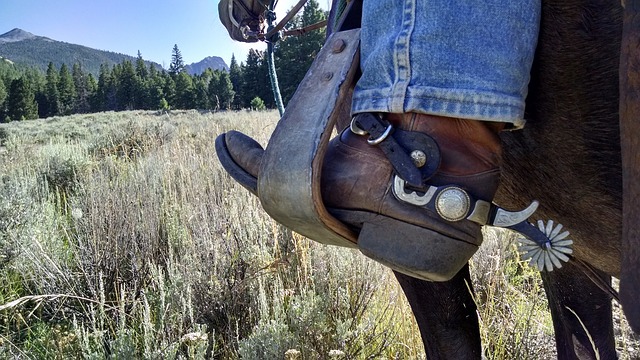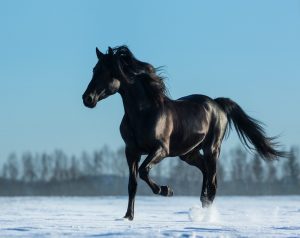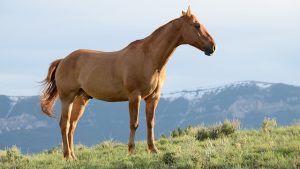When talking about horse training, it is impossible practically to separate learning ability in the horse from teaching ability in the trainer. The ability of a trainer to present his desires to a horse in a clear, concise and understandable fashion has a tremendous influence on how quickly and how thoroughly a horse learns his lessons.
Learning principles incorrectly applied can only hamper the learning process, creating confusion and often fear for the horse and frustration for the trainer. Therefore, a complete examination of learning of the horse and how it is best achieved must include a rudimentary look at the attributes, both physical and mental, necessary to be a successful trainer.
A person who hopes to be at least marginally successful at horse training should have some of the basic characteristics outlined below.
Riding Ability
Unless your goals in training horses point toward liberty acts in the circus or driving four-in-hand coaches (both of which, by the way, are exceedingly precise and challenging training processes), a good basic riding technique is necessary for you to train your horse properly. Very few well-trained horses (if any at all) are finished by sloppy riders.
Perhaps before we go any further, it should be pointed out that the type of riding ability we’re concerned with is not the “equitation” necessary to compete successfully in a Medal class at Madison Square Garden or a horsemanship class at the Quarter Horse Congress. We are concerned with functional horsemanship, and we will look at equitation not so much from the rider’s standpoint as from the standpoint of its effect on the horse’s learning process.
Many people who narrow-mindedly claim that there’s English riding and Western riding and “never the twain shall meet” may be in for a bit of an eye-opener. Good horsemanship is effective horsemanship, whether the rider is in an English saddle clearing a four-and-a-half-foot fence or on a stock saddle putting his horse through an intricate reining pattern.
Let’s look at some of the physical characteristics of effective riding. Many people, after learning what a good riding position looks like and then attempting, with varying degrees of success, to duplicate it on a horse, are overwhelmed by the physical effort required to really sit properly on a horse.
Sitting On A Horse
We all know that most people can “sit” on a horse without too much help; but to do so as an effective, active partner rather than simply as a load for the horse to bear requires some effort and practice. One of the first principles a new rider must learn is to disassociate one part of his body from another.
In other words, what your seat and legs are doing shouldn’t affect what your hands are doing. Because of this “separate but equal” approach to various parts of the rider’s body, it’s usually best to view riding position and technique from three general areas—seat and legs, upper body, and hands.
The seat and legs must perform a twofold job. They are not only a major source of the cues or aids used in riding but they must also perform the important function of keeping the rider on the horse. In the preliminary stages of riding, most people are content to let their seat and legs perform only the latter task.
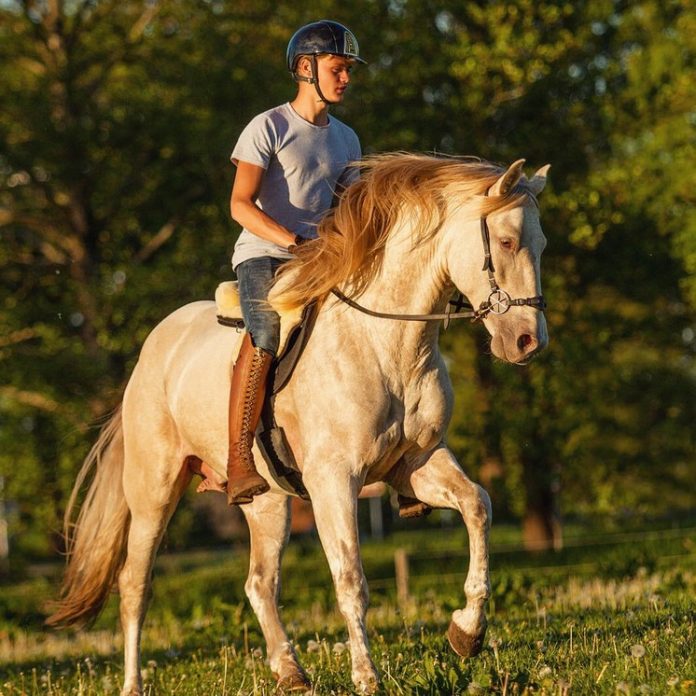
It’s only after a good deal of practice and experience that a rider begins to take full advantage of the use of his seat and legs. What is a good functional position for the seat and legs while riding a horse? Many manuals on equitation (excellent for the truly serious rider) are extremely specific, diagramming positions with mathematical angles and lines drawn through various parts of the rider’s body.
Many of these perfect positions are impossible for some riders to copy simply because of the particular rider’s individual conformation.
Good riders and trainers come in a variety of shapes and sizes, so there can always be some tailoring done to meet an individual’s needs as long as the fundamental position is adhered to as closely as possible.
The motive for positioning our seat and legs according to certain specifications is to get into and stay in balance with the horse, regardless of the gait that he is moving at or the maneuver he’s executing. Our center of gravity should be directly over his, if possible, and it should stay there, unless deliberately changed to elicit a particular response from the horse.
Even in these cases, the rider is still in balance with his horse because his position helps rather than hinders the horse’s performance. A “deep” seat is usually recommended for most riding styles, with the possible exception of hunting and jumping; and even there a deep seat provides the reassurance necessary to steady a horse approaching a fence.
In order to sit deeply in a saddle, the rider should place his weight as directly as possible over his pelvic bones, not allowing his buttocks to provide the soft cushion which seems so desirable. He should sit as far forward (toward the pommel of the saddle) as possible and allow his legs to hang freely, with the inside of his thighs (rather than the back of his thighs) against the saddle.
If a rider has the opportunity to ride in several styles of saddles (English or Western), he quickly discovers that certain saddles greatly aid him in attaining this balanced seat, while others make him work overtime simply to maintain a correct position.
Once the seat is secured correctly and the legs are hanging with the inside of the thigh resting against the saddle flap or fender, the next consideration is the position of the lower leg and the proper length of the stirrups.
There’s a lot of disagreement about lower leg position and stirrup length, and many criteria have been proposed which a rider can use to test whether his lower leg is correctly positioned.
But again, we want to look at the rider’s overall functional position, so the basic premise that we work under is that the position which allows the rider the security, control and finesse necessary to properly communicate with his horse is the correct one.
Ideally, the lower leg should rest comfortably against the sides of the horse and the knee should be bent only enough to rest the ball of the foot on the stirrup. Proper stirrup length can be determined by allowing the leg to hang naturally and then adjusting the stirrups until they hit just at or slightly below the ankle joint. Stirrup length shouldn’t be rigidly measured, however.
Variations in rider’s builds and the riding task at hand must be considered in determining proper length. A rider wanting to practice dressage or cutting cattle is more concerned with control and security and wants a longer stirrup to achieve a deeper seat.
On the other hand, a rider schooling a horse over fences or developing a horse for the race track is more concerned with allowing the horse the necessary freedom of movement to jump and gallop; the stirrups must be shorter in order to lighten his seat and, consequently, the horse’s load. which allows the rider the security, control and finesse necessary to properly communicate with his horse is the correct one.
Ideally, the lower leg should rest comfortably against the sides of the horse and the knee should be bent only enough to rest the ball of the foot on the stirrup.
Proper stirrup length can be determined by allowing the leg to hang naturally and then adjusting the stirrups until they hit just at or slightly below the ankle joint. Stirrup length shouldn’t be rigidly measured, however.
Variations in rider’s builds and the riding task at hand must be considered in determining proper length.
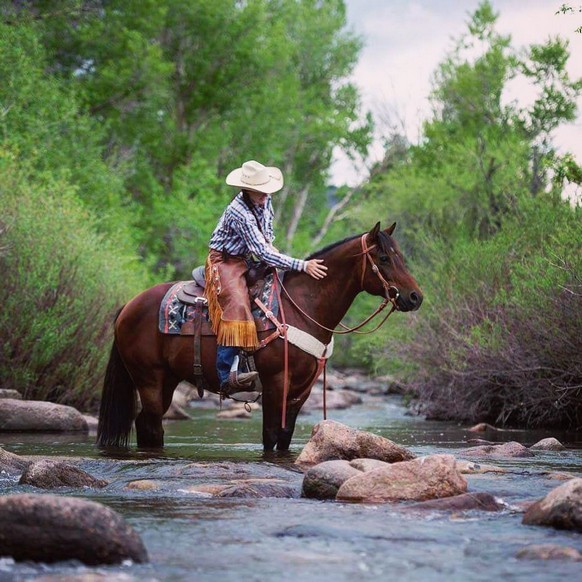
A rider wanting to practice dressage or cutting cattle is more concerned with control and security and wants a longer stirrup to achieve a deeper seat. On the other hand, a rider schooling a horse over fences or developing a horse for the race track is more concerned with allowing the horse the necessary freedom of movement to jump and gallop; the stirrups must be shorter in order to lighten his seat and, consequently, the horse’s load. under the seat and when the heels rest in a line descending through the hips and shoulders (assuming correct upper body position).
If the lower leg swings too far back it causes the rider’s upper body to fall forward, and if placed too far to the front it causes the rider to be “behind his horse,” leaning to the rear. Once the seat and lower leg positions are mastered the next step is to align the upper body. Naturally, without a strong foundation of seat and legs it’s practically impossible for the upper body to function properly. The body should be carried erect but in a relaxed manner.
Care should be taken to keep the lower back straight, not allowing it to round over. This usually happens when a rider becomes lazy and settles on his comfortable posterior instead of sitting on his seat bones.
Controlled relaxation is the goal that should be acheived in positioning the upper body. A tense rider never is able to follow and absorb his horse’s movements and is likely to transmit his tension to the horse.
At the same time, an overly relaxed rider is a sloppy one who sacrifices effectiveness in horsemanship for his own comfort.
The final elements in achieving a functional riding position are the arms and hands. Good hands are usually the last riding attributes that a horseman develops, simply because the rider must have a totally secure and independent seat, leg and upper body position before he can hope to use his hands meaningfully to transmit aids and reassurances to his horse.
Ideally, the upper arm should hang naturally from the shoulder with the elbows close but not clamped to the rider’s sides. The position of the hands may vary depending upon the stage of the horse’s training and the activity in which the horse and rider are engaged but they should be held somewhere between the lower portion of the rider’s rib cage and the point of contact between his hips and legs.
Now that we have a basic idea of what a balanced rider looks like, we must see why this position is used when training a horse. When talking about seat and leg positions, we offered evidence for the correctness of these positions in terms of the rider’s security. Some riders, however, might feel more secure with their arms draped around the horse’s neck!
We need to have even more evidence of the value of this basic position for functional training. When we watch a young horse (or any horse, for that matter) running and playing in a pasture we marvel at the speed, agility, strength, and balance of such a large animal.
At times he appears to float over the ground instead of running over it, and he has little trouble performing what are considered difficult maneuvers under saddle naturally. If these same horses are then asked to carry riders while performing much simpler movements, those that haven’t learned to carry a rider’s weight properly appear clumsy and stiff and a far cry from the graceful creatures of a few minutes before.
Many riders simply aren’t aware of the effect that a rider’s weight has on a horse’s balance, equilibrium, and muscle control. Perhaps this is why so few riders take the time and trouble to learn first what it means to be in balance with a horse and secondly, to practice this balanced position. But a simple test often illustrates this effect.
Take a backpack weighing approximately 15 percent of your body weight and adjust it so that it hangs further down on your back than it should to be carried comfortably.
Try to move normally—take a few jogging steps. Only by leaning forward and trying to move your center of gravity under the misplaced backpack can you hope to carry it with some semblance of a normal gait! This is the basic problem the horse faces. A rider who desires to work with rather than against his horse should make every effort to bring his center of gravity as closely as possible into line with that of the horse.
To accomplish this the rider must place himself in the saddle as close to the withers of the horse as possible without being directly over them. As noted before, a well-made saddle greatly facilitates accomplishing this weight distribution.
Assuming the rider is sitting in a balanced position in the saddle, what value other than the security we spoke of earlier does having the lower leg directly under him offer? It places the rider’s leg in the most effective position for cueing the horse and developing impulsion from the hindquarters without substantially affecting the horse’s balance and rhythm.
Any superfluous movements on the part of the rider that can be eliminated should be. Only those stimuli or cues necessary to achieve a desired response should be evident to dence of the value of this basic position for functional training. When we watch a young horse (or any horse, for that matter) running and playing in a pasture we marvel at the speed, agility, strength, and balance of such a large animal.
At times he appears to float over the ground instead of running over it, and he has little trouble performing what are considered difficult maneuvers under saddle naturally. If these same horses are then asked to carry riders while performing much simpler movements, those that haven’t learned to carry a rider’s weight properly appear clumsy and stiff and a far cry from the graceful creatures of a few minutes before.
Many riders simply aren’t aware of the effect that a rider’s weight has on a horse’s balance, equilibrium, and muscle control. Perhaps this is why so few riders take the time and trouble to learn first what it means to be in balance with a horse and horse training and secondly, to practice this balanced position. But a simple test often illustrates this effect.
Take a backpack weighing approximately 15 percent of your body weight and adjust it so that it hangs further down on your back than it should to be carried comfortably. Try to move normally—take a few jogging steps. Only by leaning forward and trying to move your center of gravity under the misplaced backpack can you hope to carry it with some semblance of a normal gait! This is the basic problem the horse faces.
A rider who desires to work with rather than against his horse should make every effort to bring his center of gravity as closely as possible into line with that of the horse. To accomplish this the rider must place himself in the saddle as close to the withers of the horse as possible without being directly over them. As noted before, a well-made saddle greatly facilitates accomplishing this weight distribution.
Assuming the rider is sitting in a balanced position in the saddle, what value other than the security we spoke of earlier does having the lower leg directly under him offer? It places the rider’s leg in the most effective position for cueing the horse and developing impulsion from the hindquarters without substantially affecting the horse’s balance and rhythm. Any superfluous movements on the part of the rider that can be eliminated should be.
Only those stimuli or cues necessary to achieve the desired response should be evident to cause they would not buckle under the extreme, unyielding demands of these so-called trainers. Even good trainers who have a proper perspective on the goals desired in training horses are placed in the precarious position of having to show instantaneous success with a horse if they expect to appease the horse owner. The public simply refuses to wait, and in its desire for instant gratification scorns a trainer who proceeds slowly in a systematic and sensible manner.
It is obvious then that love and respect for the horse are not the only ingredients necessary for the successful trainer; an abundance of patience and an inquisitive and systematic mind are of tremendous importance as well. The motto YOU HAVE TIME should be posted in every trainer’s tack room as a reminder that nothing is so important that it justifies rushing a horse’s training. A ribbon, a gold belt buckle, or a silver platter are little compensation for the real damage that can be done by pushing a horse beyond either his physical or mental capabilities.
In the long run, too, the material rewards for successful training will come in much greater abundance and with much more regularity to trainers who stick to a well-thought-out and properly executed training plan that takes into consideration the individual animal’s own characteristic strengths and weaknesses.
People with short tempers often find horse training a frustrating and unrewarding occupation. Horses trained through force and punishment rarely exhibit any ability beyond a mechanical obedience from fear. This obedience is quickly extinguished or forgotten if the horse is not continually reinforced with harsher and harsher methods.
Most of these horses, except for the very timid, become sour, unruly and dangerous animals. The three major psychological ingredients, then, upon which good training ability are founded are an affection for horses, patience and a large measure of self-control. Assuming an individual has these basic traits, how does he proceed to apply learning principles in horse training?
First, it is necessary to approach horse training with specific goals in mind—not simply in terms of what the finished product should look like, but also in terms of the daily progression needed to produce the finished horse. It may even be helpful to formulate a written training schedule for the horse, keeping in mind that it may vary according to the particular horse’s ability and the ability of the trainer to communicate his ideas to the horse. But by writing out a training schedule, the trainer is forced to think about what goes into the making of a well-trained horse and how best to accomplish the task.
Thinking before acting should be practiced as much as possible by horse trainers and can help to eliminate many training problems before they occur. Once the trainer knows what his goals are in training a particular horse, and how he intends to reach these goals his primary effort must be toward establishing communication with the horse. His vocabulary consists of aids—stimuli—and various forms of reinforcement that let the horse know whether he is responding correctly to these aids. What are the aids or stimuli available to the trainer?
Technically there’s no limit to them, but years of horsemen’s experience have produced certain aids that are particularly adapted for horse training. These aids include the trainer’s voice, leg pressure, weight distribution through the rider’s seat, and rein effects. These are commonly known as natural aids. In addition, there are certain artificial aids used to reinforce the natural ones. Artificial aids include the whip, spurs, side reins, check reins, martingales and other equipment.
Some riders, because of their keen observation and sensitivity naturally know when to apply aids and to what degree. Other riders must work long and hard and ride many different horses before experience begins to teach them to be truly effective riders and trainers.
Many riders don’t possess the ability, patience or desire to perfect their communication skills with the horse.
For them, the horse is a vehicle. While the rider may gain pleasure from being carried around by his horse, it is doubtful whether the horse gains much pleasure from being abused by his insensitive and ignorant rider.
